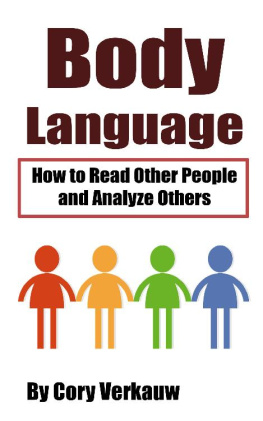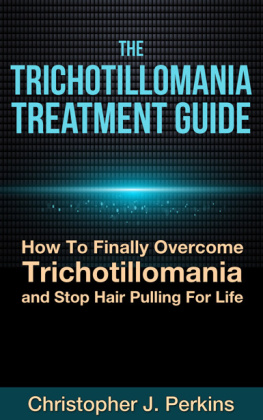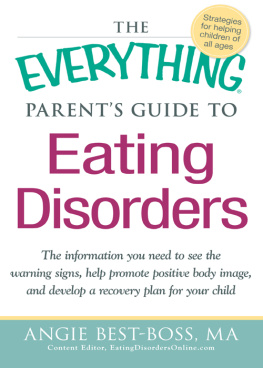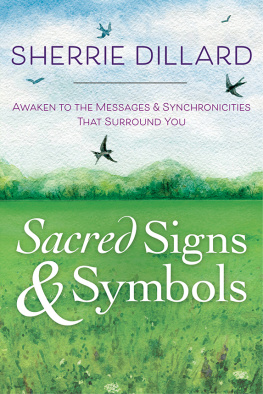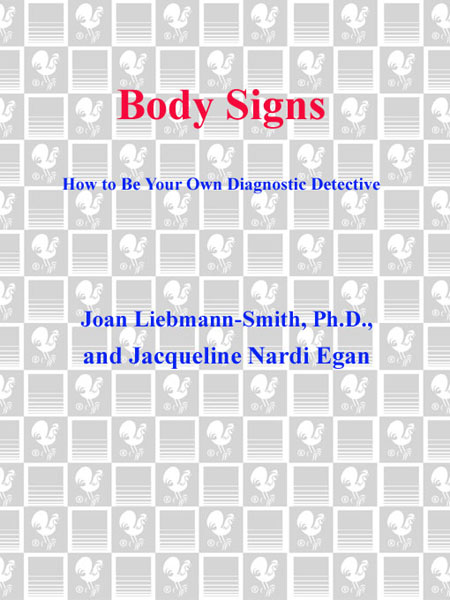
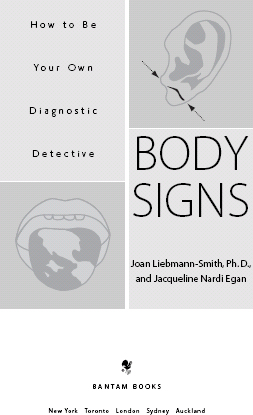
CONTENTS









APPENDIX I
BODY SIGNS REVIEW: MULTISYSTEM DISEASES AND THEIR SIGNS
APPENDIX II
BODY OF RESOURCES: RECOMMENDED WEBSITES AND BOOKS
APPENDIX III
MY BODY SIGNS CHECKUP CHECKLIST
To the memory of my parents, John and Dorothy Liebmann, both of whom died prematurely of heart disease because they and their doctors missed the warning and danger signs.
And to Richard and Rebecca, who keep my heart beating with happiness.
Joan Liebmann-Smith
To the memory of my husband, Edward, a sign that eternal love is possible; and to our daughter, Elizabeth, who continues to be a sign that hope and joy exist.
Jacqueline Nardi Egan
This book is designed to provide helpful and informative material on the subjects addressed. It is not meant to replace consultation with a physician or other licensed health care provider, particularly regarding any signs or symptoms that may require diagnosis or treatment. The authors, the publisher, and Body Signs Panel of Medical Experts expressly disclaim responsibility for any adverse effects that may result from the use or application of the information contained in this book.
ACKNOWLEDGMENTS
First and foremost, we want to thank our incomparable agent Kris Dahl for loving the idea of Body Signs as much as we did, and Jim Gorman for putting us in touch with Kris. And were very grateful to Bantam Books for embracing Body Signs with such enthusiasm. We couldnt have asked for a better editor than Beth Rashbaum. Beths outstanding editing skills, her kind, gentle prodding, and her sense of humor made working with her a pleasure. She; her assistant, Meghan Keenan; the production editor, Kelly Chian; and the art director, Paolo Pepe, were wonderfully helpful, supportive, and understanding in dealing with all our eccentricities and occasional testiness. Body Signs will be read around the world thanks to the tireless efforts of Sharon Swados and Lisa George in the subsidiary-rights division, who realized its universal appeal and spread the word.
Were indebted to Nenad Jakesevic for his terrific book jacket and chapter illustrations, and to his fellow artist and wife, Sonja Lamut, for her aesthetic input. And thanks to Michael Raab for the flattering photo.
Were very grateful to the members of our distinguished panel of medical experts for their help, comments, and input: Dr. Pete S. Batra, Dr. Wilma Bergfeld, Dr. Michael Bloom, Dr. Stephen DiMartino, Dr. Loren W. Greene, Dr. Axel Grothey, Dr. Stuart I. Henochowicz, Dr. Gordon Hughes, Dr. Alan Kominsky, Dr. Ronald Kraft, Dr. Sharon Lewin, Dr. Larry Lipshultz, Dr. Michael Osborne, Dr. Shelley Peck, Dr. Rock Positano, Dr. Joseph Scharpf, Dr. John Stangel, Dr. Randall Zusman, and Dr. Michael Bloom.
Many thanks to Richard Liebmann-Smith for his superb editorial input, not to mention his soups, stews, and sauces. And thanks to Rebecca Liebmann-Smith for her suggestions and editing skills, which someday soon may surpass even her fathers; and to Elizabeth Egan Serraillier, M.P.H., who never let us forget how important it is to educate people about their health.
Mary Diamond, Barbara Kantrowitz, Dr. Kenneth Magid, Susan Orlins, Eliza Orlins, Steve Price, and Dr. Laura Sternberg provided us with help in a variety of ways. And a special thanks to Jonathan Schwartz, whose National Public Radio show made working on weekend afternoons tolerable, if not enjoyable.
Finally, a big thank-you to our friends and relatives, who bombarded us with their bizarre body signs andmore importanttheir love, support, and understanding when we had to decline or cancel social engagements.
INTRODUCTION
Observe, record, tabulate. Use your five senses.
Learn to see, learn to hear, learn to feel, learn to smell and know that by practice alone can you become experts.
SIR WILLIAM OSLER (18491919), CANADIAN PHYSICIAN KNOWN AS THE FATHER OF MODERN MEDICINE
W e all notice things about our bodies that are annoying, weird, unsightly, or downright embarrassing. Our nails may be yellow. Skin tags may suddenly pop up under our breasts. Or our partners may complain that we smell like ammonia. These are body signs. If we learn how to decode them, they can tell us a lot about our state of healthor illness.
Fortunately, many body signs are often benign. By this we mean an indicator of a condition that is harmless or medically unimportant. (This use of the word should not be confused with benign as the opposite of malignant or cancerous.) Body signs that are benign can simply be ignored or treated cosmetically. But some body signs may signal something more serious. While those yellowed nails may be nicotine stains, they may also be a warning sign of a lung or liver disorder. Unsightly skin tagsa common sign of agingmay signal diabetes. And while the ammonia-like odor you give off may mean you should hire a cleaning service, it can also mean that youre eating too much protein. Or it may be a warning sign that youre harboring the Helicobacter pylori bacterium, the bug that causes stomach ulcers. These medical messages are not merely random occurrences. Rather, they are sent by our bodies to warn us that something may be out of kilter.
Body Signs is about how our bodies communicate our internal health status through external signs and signals. Unlike symptoms, which tend to involve pain or discomfort and are likely to send you running to your doctors office or even the emergency room, body signs are more likely to send you scurrying off to your hairdresser, nail salon, cosmetic counter, or drugstore. Or if you do go to a doctor, youre more apt to consult a plastic surgeon than an internist. But an internist may be exactly what you need. Sometimes what may seem like a cosmetic concern is more than meets the eye. For example, small, yellowish, and often ugly skin growths may show up on your eyelids. Medically known as xanthelasmas, theyre actually tiny deposits of cholesterol forewarning that you may have high cholesterol and be at risk for heart disease.
WHATS THE DIFFERENCE BETWEEN A BODY SIGN AND A SYMPTOM?
Symptomssuch as pain, fever, and bleedingcome in loud and clear. But body signs tend to be more subtle and difficult to interpret; we may find them dull and banal, embarrassing and bizarre, or anything in between. As John Brown, a 19th-century Scottish physician, put it, Symptoms are the bodys mother tongue; signs are in a foreign language. And while only patients can describe their symptoms, many body signs can be detected by patients, physicians, partners, and even passersby. Body signs are detected by using the five senses; they can be seen, heard, tasted, felt, or smelled.
Next page

